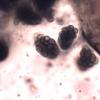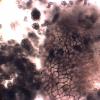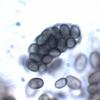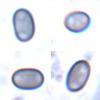
20-12-2025 23:08
Patrice TANCHAUDBonsoir, récolte sur sol sablonneux dans l'arri�

21-12-2025 09:32
Hello.A tiny ascomycete found embedded in wood in

20-12-2025 15:47
Mirek GrycHi.These grew on pine wood that was heavily covere

18-12-2025 21:17
Pol DebaenstThe identification took me to Byssonectria deformi

15-12-2025 07:09
 Danny Newman
Danny Newman
indet. Rutstroemiaceae sp. on unk. fallen leavesMc

19-12-2025 10:10
Patrice TANCHAUDBonjour, récolte réalisée en milieu dunaire, a

18-12-2025 17:23
 Bruno Coué
Bruno Coué
Bonjour,je serais heureux d'avoir votre avis sur c

18-12-2025 18:07
Margot en Geert VullingsThese plumes were found on rotten wood.They strong
Dung fungi?
Malcolm Greaves,
08-09-2017 14:06
Can anyone help
Thanks
Mal
Norbert Heine,
08-09-2017 16:07

Re : Dung fungi?
Hallo Mal,
you should compare with Westerdykella nigra (=Preussia nigra).
At first with 8 spores, immediately separating and soon with 32 ascospore segments.
4-5,2 x 2,4-3 µm.
Regards, Norbert
you should compare with Westerdykella nigra (=Preussia nigra).
At first with 8 spores, immediately separating and soon with 32 ascospore segments.
4-5,2 x 2,4-3 µm.
Regards, Norbert
Malcolm Greaves,
08-09-2017 21:08
Re : Dung fungi?
Hello Norbert
I don't have any detailed description of Westerdykella nigra but from what I can gather it is a close relative of Sporormiella. These also split into segments and have a spore septa. Looking more closely at my find the spores do not look to be grouped in the asci and I see no sign of the septa in fact I think I can see droplets at each end of the spores. I don't know if this would rule out the Westerdykella (Preussia) group.
Mal
I don't have any detailed description of Westerdykella nigra but from what I can gather it is a close relative of Sporormiella. These also split into segments and have a spore septa. Looking more closely at my find the spores do not look to be grouped in the asci and I see no sign of the septa in fact I think I can see droplets at each end of the spores. I don't know if this would rule out the Westerdykella (Preussia) group.
Mal
Norbert Heine,
09-09-2017 00:18

Re : Dung fungi?
Hello Mal,
yes, the genus Westerdykella seems to be near to Sporormiella, Preussia.
Another option for the species you found could be W. cylindrica (Asci 17-25 x 9-10).
The asci of W. nigra should be larger (30-40 x 9-11).
We spoke about Westerdykella nigra / cylindrica / multispora in the german Pilzforum.eu some years ago.
At answer #6 you can find two pdf.
In the Doveri article there's a description of W. cylindrica (p. 209-212) and in the article by Ebead et al you can find a key (p. 197-198).
The discussion you will find here (sorry, in german):
https://www.pilzforum.eu/board/thema-westerdykella-cylindrica
Maybe this will help you a little bit more.
Norbert
yes, the genus Westerdykella seems to be near to Sporormiella, Preussia.
Another option for the species you found could be W. cylindrica (Asci 17-25 x 9-10).
The asci of W. nigra should be larger (30-40 x 9-11).
We spoke about Westerdykella nigra / cylindrica / multispora in the german Pilzforum.eu some years ago.
At answer #6 you can find two pdf.
In the Doveri article there's a description of W. cylindrica (p. 209-212) and in the article by Ebead et al you can find a key (p. 197-198).
The discussion you will find here (sorry, in german):
https://www.pilzforum.eu/board/thema-westerdykella-cylindrica
Maybe this will help you a little bit more.
Norbert
Malcolm Greaves,
09-09-2017 01:34
Re : Dung fungi?
Norbert
Reading through those articles W cylindrica looks a perfect match.
Thanks for that.
Mal
Reading through those articles W cylindrica looks a perfect match.
Thanks for that.
Mal





